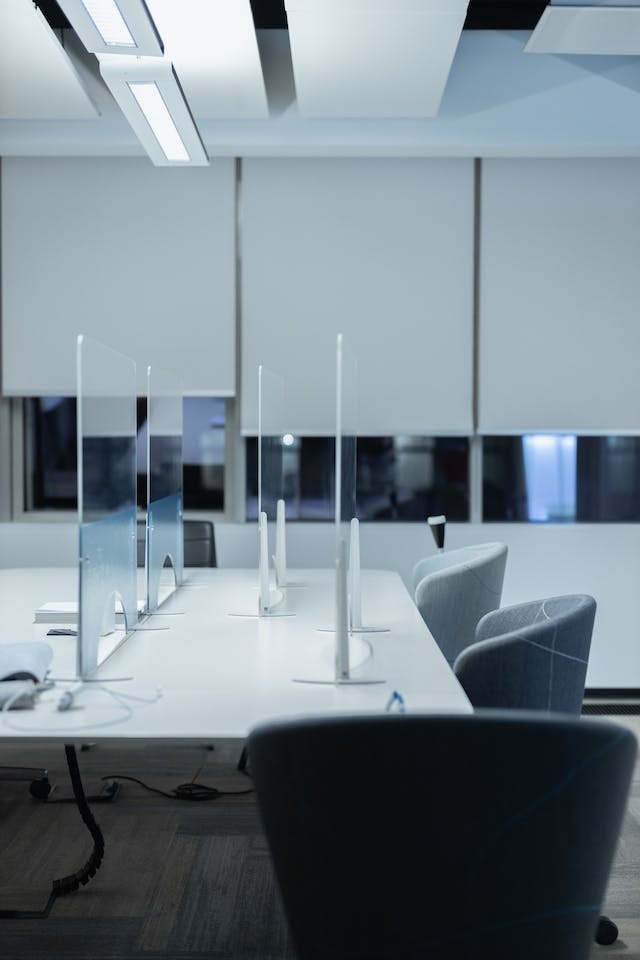Open Office Spaces: What Employers Need to Know
Tue, 30 Jan 2024

Open office spaces have become increasingly popular in recent years, with many companies adopting this layout to promote employee collaboration and communication.
However, this trend has also sparked a debate among employers regarding its effectiveness and impact on productivity.
Are open office spaces truly beneficial for businesses, or do they create more distractions and hinder concentration?
Let's find out the pros and cons of open office spaces and provide valuable insights for employers considering implementing this layout in their workplaces.
Understanding Open Office Spaces
Open office spaces are layouts without walls or barriers designed to encourage interaction and collaboration among employees.
You might picture a floor filled with desks, with employees working side by side. Sounds productive and team-oriented, doesn't it?
But it's not that simple.
Now, let's critically analyse this concept. While these spaces promise increased communication, they can also lead to distractions and a lack of privacy.
You're caught in a paradox. You want your team to collaborate, but you don't want them to lose focus due to excessive noise or interruptions.
Understanding open office spaces isn't just about knowing what they are. It's about identifying their challenges and harnessing innovation to turn potential negatives into positives.
And that's the first step to making them work for your business.
Advantages of Open Office Layouts
Fosters Collaborative Environment
This type of office design eliminates barriers like cubicles and walls, allowing for an unobstructed flow of communication and interaction.
Employees can easily approach each other for discussions, brainstorming sessions, or casual conversations. These interactions often result in innovative ideas and solutions, which can benefit overall business productivity.
Moreover, it fosters a sense of team unity and cooperative spirit among the employees. As everyone shares the same space, they tend to develop a shared understanding of purpose and work towards common goals.
Cost-Effective
Open office layouts can be more cost-effective compared to traditional office designs.
They typically require less square footage per employee, as there are no individual offices or cubicles to account for. This can result in significant savings on rental costs, especially in high-rent areas.
For instance, the cost range for coworking spaces in Kuala Lumpur can vary. The average figures for coworking spaces in Kuala Lumpur can start from as low as RM30/day for day passes and go up to RM2,390/month for private offices.
These prices are subject to change depending on the amenities, location, and facilities each coworking space provides.
Usually, for such offices, amenities, such as furniture, internet access, printing facilities, kitchenettes, and meeting rooms, are included in the monthly rental costs. Thus, there's no need to purchase such items separately.
Flexibility and Scalability
Unlike traditional offices which require construction or significant changes to reconfigure the space, open office layouts can be easily adjusted to accommodate changing needs.
This includes adding new employees, creating different functional areas, or changing the layout.
This scalability allows companies to adapt quickly to changes without the need for major renovations or investments. It also allows businesses to experiment with different layouts to find the most productive setup for their team.
Enhances Transparency
With everyone working in a shared space, it's easier for managers and supervisors to monitor the work process and progress. This can lead to increased accountability and work ethics, as employees may be more motivated to work when they know their performance can be easily observed.
On the other hand, it also promotes transparency from the management side. Employees can see their leaders working alongside them, which can foster trust and respect.
This type of transparency can contribute to a more open, honest work culture where everyone feels valued and involved.
Potential Drawbacks of Open Spaces
Lack of Privacy
Open office spaces often come with a significant decrease in privacy as employees no longer have individual cubicles or offices, making it difficult to concentrate on their tasks without being interrupted.
Around 30% of workers indicate that a lack of privacy causes them to hold back when conversing with colleagues or on the phone.
Moreover, this lack of privacy can increase stress levels and decrease employee satisfaction, as individuals may feel like they're constantly being watched or judged by their coworkers.
In terms of confidentiality, open office spaces can pose a risk. Sensitive information can be easily overheard or seen by others.
Noise Distraction
Without physical barriers to block sound, employees are subjected to the constant noise of their colleagues' conversations, phone calls, and even just the noise of their typing or clicking.
This can make it difficult for employees to concentrate on tasks, leading to decreased productivity.
In a survey concerning open office spaces, an overwhelming 99% of respondents reported that their environment easily distracted them.
Therefore, an open office space can be highly disruptive for employees who require a quiet environment to work effectively.
Lack of Personal Space
Open office spaces also mean less personal space, which can be uncomfortable for many employees. The sense of ownership of having a private office or cubicle is lost in an open office layout.
Employees might feel they lack a space where they can express their individuality, which can impact morale and satisfaction levels.
Furthermore, sharing workspace can lead to disagreements over cleanliness, noise, and even temperature.
Steps To Implement Open Office
Step 1: Assess Your Current Workspace
Assess your existing workspace by understanding the current layout, identifying the available space, and determining the necessary changes. Consider the type of work your team does, as an open office plan might not be suitable for all kinds of work.
For example, roles that require intense concentration or confidentiality might not thrive in an open office environment.
Another critical aspect of this step is understanding your employees' needs and preferences.
Engage them in the process and try to understand their views on moving to an open office plan. Their input can provide valuable insights into what kind of environment will be most conducive to productivity and satisfaction.
Step 2: Create a Detailed Plan
Once you've assessed your current workspace and gathered employee input, the next step is to create a detailed plan for the open office layout.
This should include the placement of desks, meeting areas, quiet spaces, and other necessary facilities. It's essential to balance openness with the need for privacy and quiet workspaces.
In creating this plan, consult with relevant professionals who have experience in office design. They can provide expert advice on the best use of space and can help you avoid common pitfalls.
Additionally, be sure to consider health and safety regulations, as well as accessibility needs.
Step 3: Implement the Plan
After finalising the plan, it's time to put it into action.
This might involve purchasing new furniture, tearing down walls, or rearranging existing furniture. It's crucial during this phase to keep employees informed and to minimise disruptions as much as possible.
Another option is to rent an office or coworking space since they are furnished and often have already implemented open office plans.
Remember to be flexible during the implementation phase.
Step 4: Monitor and Adjust
Once you've implemented the open office layout, monitor how it's working. Regularly check in with employees to get their feedback. Are they able to concentrate? Do they have enough privacy? Are there enough meeting spaces?
Some things might not go as planned, or you might find that certain design aspects don't work as well in practice as they did on paper. Be ready to make adjustments as necessary to create the most effective workspace.
Use this feedback to make any necessary adjustments to the layout. Remember, the goal is to create a workspace that promotes productivity, collaboration, and employee satisfaction.
If certain aspects of the open office design hinder these goals, expect to make changes. The open office plan should be flexible and adaptable to the evolving needs of your team.
In Short,
Open office spaces can be powerful tools for fostering collaboration and boosting productivity if adequately managed. Be aware of potential drawbacks, like noise distractions and a lack of privacy.
Innovate and adapt to make these spaces work for your organisation. Remember, balance is vital; consider integrating quiet zones or flexible work hours.
Open offices can truly flourish if you listen to your employees' needs and adapt accordingly.
At Upscale, our talent acquisition experts are here to help you to assist with all aspects of workplace design.
From creating a detailed plan to providing insights on potential pitfalls, we are here to ensure your team is as effective and productive as possible.
Contact us today at upscale.my for more information and get started on transforming your team!
